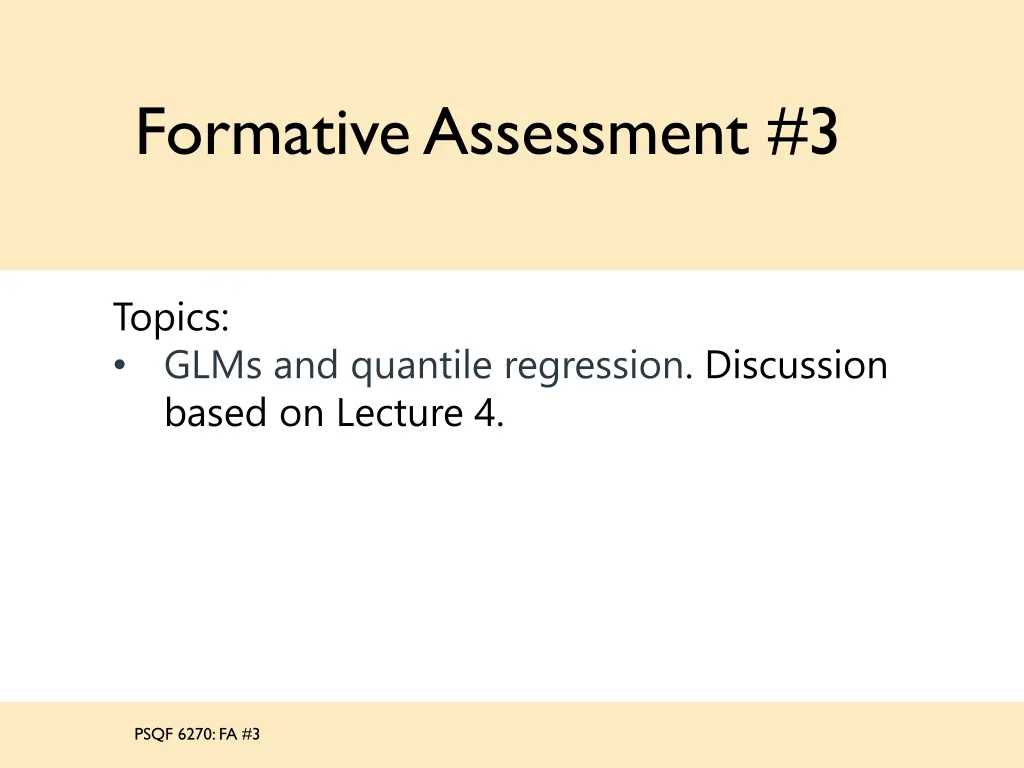
GLMs and Quantile Regression: Discussion on Topics in Formative Assessment #3
Explore topics on Generalized Linear Models (GLMs) and quantile regression in Formative Assessment #3 for PSQF 6270. Dive into discussions based on Lecture 4, covering various aspects like zero-inflated vs. hurdle models, over-dispersion vs. under-dispersion, interpretation of model results, and more.
Download Presentation

Please find below an Image/Link to download the presentation.
The content on the website is provided AS IS for your information and personal use only. It may not be sold, licensed, or shared on other websites without obtaining consent from the author. If you encounter any issues during the download, it is possible that the publisher has removed the file from their server.
You are allowed to download the files provided on this website for personal or commercial use, subject to the condition that they are used lawfully. All files are the property of their respective owners.
The content on the website is provided AS IS for your information and personal use only. It may not be sold, licensed, or shared on other websites without obtaining consent from the author.
E N D
Presentation Transcript
Formative Assessment #3 Topics: GLMs and quantile regression. Discussion based on Lecture 4. PSQF 6270: FA #3
Q1 Are there any topics that you'd like to review more in class? PSQF 6270: FA #3
Q1 Notes Interactions (x3) Recode and collapse variables Zero-inflated vs. hurdle models Over-dispersion vs under-dispersion Interpretation of model results in real examples Gamma distribution and logit link-function Poisson Conditional Distribution FA/Discussion in class about models (and slide 20 from lecture 4) PSQF 6270: FA #3
Q2 Describe how generalized models with logit/probit links and binomial-family distributions can be used to predict accuracy (i.e., percent correct). What concerns should we be aware of when using a conditional binomial distribution? PSQF 6270: FA #3
Q2 Notes (Slides 58) Binomial-family models: Continuish outcomes with two limits. The inverse-link function keep the predicted probability within 0 and 1. Conditional distribution adequately represents the concentration and dispersion of the outcomes When using a binomial distribution, check: Overdispersion (Pearson ?2statistic) Zeros and ones (inflation) PSQF 6270: FA #3
Q3 For what kind of outcomes and in what situations might quantile regression be used? Please give an example of a research question that it could answer. PSQF 6270: FA #3
Q3 Notes (Slides 1719) Situation: Outliers can affect the usefulness of the predicted mean of our continuish outcome. The focus is on a particular part of the outcome distribution. We can predict any percentile (e.g., conditional median) of the outcome and use resampling methods to obtain correct SEs for the FEs. RQ: Does the relationship between the number of hours slept and academic achievement vary between students with a low and a high GPA (e.g., 25th percentile vs 75th or 90th percentile)? PSQF 6270: FA #3
Q4 In general, how would you know: (a) whether you need a link function to predict an outcome in a regression model, and (b) whether it should be in the logit/probit family or the log family? PSQF 6270: FA #3
Q4 Notes a) The outcome has limits that does not align with the predictions of the general linear regression. b) Considering the limits of the observed outcome. PSQF 6270: FA #3
Q5 How do the generalized linear models we've seen so far address or not address the following assumptions of typical "linear regression" (i.e., general linear models) about model residuals: independence, normality, and constant variance? PSQF 6270: FA #3
Q5 Notes Independence = we continue to assume that the residuals are independent of each other. Normality and Homoscedasticity = the conditional distribution will dictate the shape of the distribution of the residuals and the variance function. PSQF 6270: FA #3
Formative Assessment #3 Topics: GLMs and quantile regression. Discussion based on Lecture 4. PSQF 6270: FA #3
